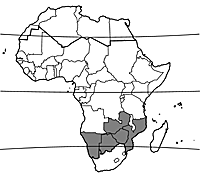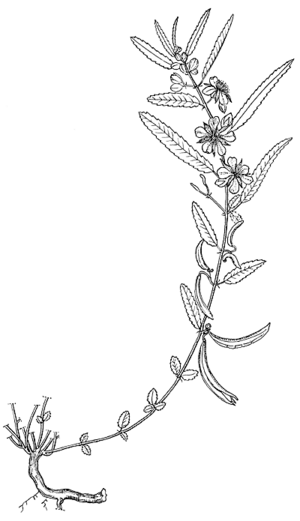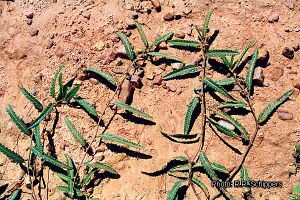Corchorus asplenifolius (PROTA)
Introduction |
| General importance | |
| Geographic coverage Africa | |
| Geographic coverage World | |
| Vegetable | |
| Medicinal | |
| Forage / feed | |
| Food security | |
Corchorus asplenifolius Burch.
- Protologue: Trav. S. Africa 1: 400 (1822).
- Family: Tiliaceae (APG: Malvaceae)
- Chromosome number: 2n = 14
Vernacular names
- Wild Jew’s mallow (En).
- Corète sauvage (Fr).
Origin and geographic distribution
Corchorus asplenifolius is restricted to southern Africa, from Zambia southwards to South Africa and Swaziland. It is common at the fringes of the Kalahari desert.
Uses
The mucilaginous texture of the foliage makes it a popular leafy vegetable when consumed together with a coarse staple food. In the past, ashes from this plant were used as a substitute for salt. The ash is said to dispel ants.
Production and international trade
This vegetable is frequently collected from the wild during the rainy season for home consumption and for sale at local markets and urban centres (e.g. Bulawayo in Zimbabwe).
Properties
The composition of Corchorus asplenifolius is probably comparable to that of Corchorus olitorius.
Adulterations and substitutes
Corchorus asplenifolius can be replaced by okra or other Corchorus species found in the same region, especially Corchorus tridens L. and Corchorus trilocularis L.
Description
- Perennial herb with prostrate or suberect annual stems from a woody rootstock; stems glabrous or with a line of short, curly hairs, sometimes also with spreading hairs all around.
- Leaves alternate, simple; stipules setaceous, up to 1 cm long; petiole up to 1 cm long; blade lanceolate to almost linear, 1.5–8 cm × 0.2–1.5 cm, rounded or broadly cuneate and without setaceous appendages at base, acute at apex, margin coarsely or finely serrate or crenate, glabrous to densely hispid.
- Inflorescence a 1–3-flowered leaf-opposed fasciculate cyme, bracteate.
- Flowers bisexual, regular, usually 5-merous, shortly stalked; sepals free, linear to linear-oblanceolate, 6–10 mm long; petals free, oblanceolate to obovate, 6–10 mm long, yellow; stamens numerous; ovary superior, 3-celled, style up to 7 mm long.
- Fruit a slender cylindrical capsule up to 4 cm long and c. 2 mm wide, attenuated to a blunt, undivided apex, dehiscing by 3 valves, usually on twisted stalk, many-seeded.
- Seeds shortly cylindrical, 1.3–2 mm long, dark brown.
Other botanical information
The genus Corchorus comprises an uncertain number of species, with estimates ranging from 40–100. Corchorus asplenifolius can be identified by its woody rootstock and often prostrate stems having narrow leaves and 3-valved capsules, often on twisted stalks. It resembles Corchorus confusus Wild, but this species usually has broader leaves and straight fruit stalks.
Growth and development
Corchorus asplenifolius is one of the few perennial Corchorus species. In the dry season, it is often burnt down to ground level, but it sprouts again when the rainy season starts. It flowers mainly in the mid-rainy season, between December and March.
Ecology
Corchorus asplenifolius occurs in open woodland and at the margins of seasonal swamps, usually on sandy soils.
Harvesting
Tops of leafy stems and leaves are collected from the wild.
Handling after harvest
Harvested leaves may be dried, made into powder and kept for use during the dry season.
Genetic resources
Although Corchorus asplenifolius is not very widespread, it does not seem to be liable to genetic erosion because it is variable in morphology, locally common and may resprout from its woody rootstock left behind after collecting leafy stems.
Prospects
Corchorus asplenifolius is a locally common and nutritious vegetable and as such a valuable wild plant. It only fetches low prices at markets, so there is little incentive to domesticate it and consider commercial production. The perennial habit may make it suitable for home garden planting for regular supply as a green vegetable for family consumption.
Major references
- Edmonds, J.M., 1990. Herbarium survey of African Corchorus L. species. Systematic and Ecogeographic Studies on Crop Genepools 4. IBPGR/IJO, Rome, Italy. 284 pp.
- Schippers, R.R., 2000. African indigenous vegetables. An overview of the cultivated species. Natural Resources Institute/ACP-EU Technical Centre for Agricultural and Rural Cooperation, Chatham, United Kingdom. 214 pp.
- Tredgold, M.H., 1986. Food plants of Zimbabwe. Mambo Press, Gweru, Zimbabwe. 153 pp.
- Wild, H., 1963. Tiliaceae. In: Exell, A.W., Fernandes, A. & Wild, H. (Editors). Flora Zambesiaca. Volume 2, part 1. Crown Agents for Oversea Governments and Administrations, London, United Kingdom. pp. 33–91.
- Wild, H., 1984. Tiliaceae. In: Leistner, O.A. (Editor). Flora of southern Africa. Volume 21, part 1. Botanical Research Institute, Department of Agriculture, Pretoria, South Africa. 44 pp.
Other references
- Leung, W.-T.W., Busson, F. & Jardin, C., 1968. Food composition table for use in Africa. FAO, Rome, Italy. 306 pp.
- Wild, H., Biegel, H.M. & Mavi, S., 1972. A Rhodesian botanical dictionary of African and English names. 2nd Edition. Government Printer, Salisbury, Rhodesia.
Sources of illustration
- Wild, H., 1984. Tiliaceae. In: Leistner, O.A. (Editor). Flora of southern Africa. Volume 21, part 1. Botanical Research Institute, Department of Agriculture, Pretoria, South Africa. 44 pp.
Author(s)
- R.R. Schippers, De Boeier 7, 3742 GD Baarn, Netherlands
Correct citation of this article
Schippers, R.R., 2004. Corchorus asplenifolius Burch. [Internet] Record from PROTA4U. Grubben, G.J.H. & Denton, O.A. (Editors). PROTA (Plant Resources of Tropical Africa / Ressources végétales de l’Afrique tropicale), Wageningen, Netherlands.
Accessed 6 March 2025.



